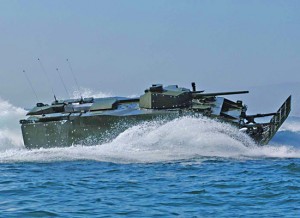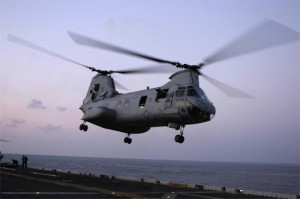Before we address the issue of Secretary of Defense Robert Gates’ position on the sea services, let’s debunk the mythical notion that either the military or the campaigns in Iraq and Afghanistan is bankrupting the country (or even demanding the lion’s share of money). From CATO (h/t Glenn Reynolds at Instapundit).

That’s quite enough said about that. On to the sea services.
“Our current plan is to have eleven carrier strike groups through 2040,” Gates said. But a look at the facts is warranted, he added. The United States now has 11 large, nuclear-powered carriers, and there is nothing comparable anywhere else in the world.
“The U.S. Navy has 10 large-deck amphibious ships that can operate as sea bases for helicopters and vertical-takeoff jets,” he said. “No other navy has more than three, and all of those navies belong to allies or friends.”
The U.S. Navy can carry twice as many aircraft at sea as the rest of the world combined, Gates said. Under the sea, he told the group, the United States has 57 nuclear-powered attack and cruise-missile submarines – more than the rest of the world combined, and 79 Aegis-equipped surface ships that carry about 8,000 vertical-launch missile cells.
“In terms of total-missile firepower, the U.S. arguably outmatches the next 20 largest navies,” Gates said. “All told, the displacement of the U.S. battle fleet – a proxy for overall fleet capabilities – exceeds, by one recent estimate, at least the next 13 navies combined, of which 11 are our allies or partners.”
The United States must be able to project power overseas, Gates said. “But, consider the massive overmatch the U.S. already enjoys,” he added. “Consider, too, the growing anti-ship capabilities of adversaries. Do we really need 11 carrier strike groups for another 30 years when no other country has more than one?”
The Marine Corps is now 202,000 strong. It is the largest force of its type in the world, and exceeds in size most nations’ armies. Between the world wars, the Marine Corps developed amphibious warfare doctrine and used it to great effect against the Japanese during World War II. Whether that capability still is needed, however, is worthy of thought, the secretary said.
“We have to take a hard look at where it would be necessary or sensible to launch another major amphibious landing again – especially as advances in anti-ship systems keep pushing the potential launch point further from shore,” Gates said. “On a more basic level, in the 21st century, what kind of amphibious capability do we really need to deal with the most likely scenarios, and then how much?”
The Expeditionary Fighting Vehicle (EFV) will take a particularly tough beating over the course of the next several months and years, but the Marines have rolled out their case.
The Marine Corps unveiled its new $13 billion landing-craft program on Tuesday, a day after Defense Secretary Robert Gates questioned the Pentagon’s need for it …
“Secretary Gates has placed his marker, and he’s not in favor of continuing the program,” said Dakota Wood, a military analyst at the Center for Strategic and Budgetary Assessments and a retired Marine officer. “The Marine Corps is going to have to come up with a whale of a rationale to convince him otherwise.”
The need, the Marines say, stems from their need to replace its Nixon-era Amphibious Assault Vehicles. The new vehicle will allow Marines to land on a hostile shore, a capability needed, for example, in the withdrawal of U.S. forces from Somalia in the 1990s and civilians from Lebanon in 2006, said Lt. Gen. George Flynn, who leads the Marine Corps Combat Development Command. The amphibious capability also forces adversaries to undertake “costly defensive measures,” Flynn said.
Analysis & Commentary
The issue of expense of military hardware, systems and size has nothing to do with overspending. It pertains to the relative commitment of this particular administration to national defense as opposed to government-run, government-administered programs and subsidies. We have the economy to support an even larger military than we currently have. What we don’t have is the national will.
Aircraft carriers, as much or more than any other military hardware, is a way of projecting power across the globe. My support of them is well known, and my support for the F-22 program has been made clear. In fact, I have proposed an increase rather than a decrease in Carrier battle groups. The size of the Marine Corps is not a problem for the national economy, and it’s easy to question expenditures for a strong national defense while comfortably enjoying the peace and security that it has brought.
But this isn’t the same thing as questioning the need for the EFV and the forcible entry doctrine of the Marine Corps. I have taken the doctrine to task.
I do not now and have never advocated that the Marine Corps jettison completely their notion of littoral readiness and expeditionary warfare capabilities, but I have strongly advocated more support for the missions we have at hand.
Finally, it occurs to me that the debate is unnecessary. While Conway has famously said that the Corps is getting too heavy, his program relies on the extremely heavy Expeditionary Fighting Vehicle, that behemoth that is being designed and tested because we want forcible entry capabilities – against who, I frankly don’t know.
If it is a failing state or near failing state, no one needs the capabilities of the EFV. If it is a legitimate near peer enemy or second world state, then the casualties sustained from an actual land invasion would be enormous. Giving the enemy a chance to mine a beach, build bunkers, arm its army with missiles, and deploy air power, an infantry battalion would be dead within minutes. 1000 Marines – dead, along with the sinking of an Amphibious Assault Dock and its associated EFVs.
No one has yet given me a legitimate enemy who needs to be attacked by an EFV. On the other hand, I have strongly recommended the retooling of the expeditionary concept to rely much more heavily on air power and the air-ground task force concept. It would save money, create a lighter and more mobile Marine Corps (with Amphibious Assault Docks ferrying around more helicopters rather than LCACs), and better enable the Marines to perform multiple missions. I have also recommended an entirely new generation of Marine Corps helicopters.
This is not suggesting that the Marine Corps in any way needs to have its funding cut or decrease its size. It is to suggest that the money might be more wisely spent in other areas. The mission still isn’t clear. Above it has been suggested that the Corps needs the EFV for withdrawal of forces (such as from Somalia) or evacuation of civilians (such as from Lebanon). But this explanation doesn’t comport with the facts of the program. “The Corps aims to buy a total of 573 EFVS. This would give it the capacity to amphibiously transport eight infantry battalions of about 970 Marines and sailors per battalion, the Congressional Research Service said in a report dated August 3, 2009.”
We don’t need 573 EFVs and eight infantry Battalions to evacuate civilians from Lebanon. The Corps obviously plans to replace its amphibious transport of Marines (currently with the LCAC) with the EFV. The Corps also plans to continue its doctrine of amphibious-based forcible entry. But as I have pointed out, there is no reason that this cannot be done via air and a new helicopter fleet. If the plan is to be prepared to invade a near-peer via an amphibious landing, this is lunacy and madness. If the plan is to save ships by allowing them to be 25 miles offshore, this is naive and sophomoric. The Navy had better be designing better counter-measures.
While there is every good reason to be more efficient in both military spending and non-defense spending, there is no good reason to cut funding to the Corps. But the Corps needs to rethink its basic doctrine and reassess the real need for the EFV. Going in the direction of a lighter, air-sea-based, rapid reaction force has its merits, and should warrant some attention. Gates should hear fresh thinking from the U.S. Marine Corps, not warmed over 60 year old doctrine. It’s too bad that the QDR, that brainchild of Michelle Flourney, is such an incredible waste of ink and paper. It would have been a good repository for fresh thinking.







